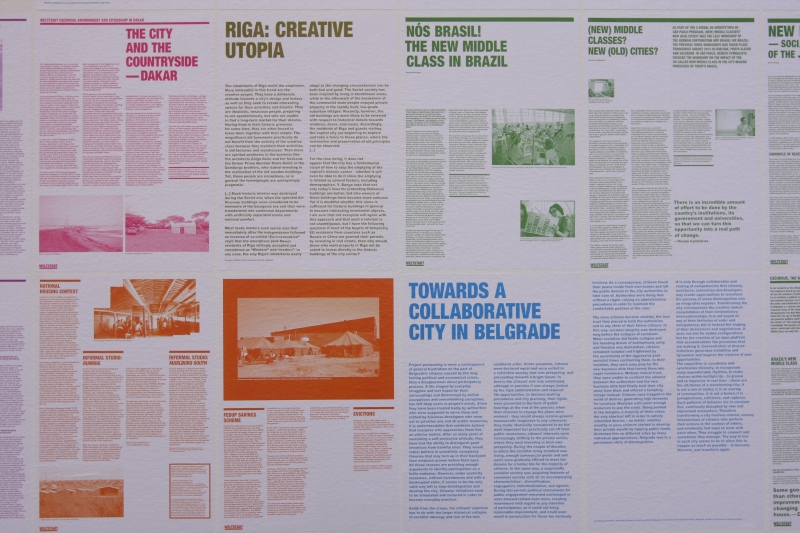Who creates the city? Who shapes its future? asks the introduction to the exhibition “Weltstadt – Who creates the city?” currently showing at the Deutsches Architektur Zentrum, DAZ in Berlin.
Hang on…..? Haven’t we seen similar questions somewhere else recently…..?
Of course…… at Konstantin Grcic – Panorama at the Vitra Design Museum, in the context of which we wrote “How each of us responds and reacts to such challenges will ultimately affect the nature of our cities, and so determine if we become the future we want. Do we really want to leave such considerations to designers?”
Presenting the results of 10 “city making” projects initiated by the German Goethe-Institut in 17 metropoles, Weltstadt – Who creates the city? not only demonstrates that we don’t have to leave such considerations to designers; but in comparison to the abstract, conceptual way chosen by Konstantin Grcic is an exhibition of practical examples.
By its very nature Weltstadt – Who creates the city? is a text heavy exhibition, you will need to take a bit of time with you, but it will be time well invested for you will learn about, for example, the Marlboro South informal settlement in Johannesburg where with the help of architecture students the residents are preparing their own plans for developing their community – and so saving it from developers. Or NextBangalore a sort of urban crowdsourcing initiative which aims to involve the people of Bangalore in decisions being taken about the development of their city. But its not all “Third World”, Weltstadt – Who creates the city? also presents projects in, for example, New York, Riga, Seoul and a joint project being staged in Lisbon, Madrid, Toulouse, Turin and Berlin.
The result is a nicely curated collection of projects which show both that participatory urban planning and regeneration is possible, and that it can achieve tangible results that go beyond those immediately involved in the project.
In place of an exhibition catalogue a series of newspapers have been produced each of which documents the local projects. The visitor is invited to take those that interest them home in a special exhibition paper bag, thus creating their own, personal catalogue. A nice idea, but one which implies that no-one in the Goethe-Institut, the global project groups or among the exhibition curators are of the opinion that sensible resource use might have a role to play in successful cities of the future. We know that’s not true, but it’s the impression one gets.
Yes the newspapers are also available as an online blog, but that isn’t really promoted in the exhibition, and when you do visit the blog there is just the most annoying banner that moves horizontally across the bottom of the screen whenever you scroll: scroll up it moves left, scroll down it moves right. The effect is that reading the texts is made all but impossible, so distracted is one by the senseless counter scroll. It is, simply put, plain idiocy.
It sounds like a small gripe given the work that has gone into the project and the importance of the issues raised, but……
And it is our only gripe. You won’t like or agree with all the positions and projects presented in the exhibition, but no-one is saying you have to. Weltstadt – Who creates the city? is about promoting a dialogue, of encouraging discussion and for all about motivating each and every one of us to think about our own communities and our own cities and to consider what could be improved. And for all how.
Weltstadt – Who creates the city? runs at the Deutsches Architektur Zentrum DAZ, Köpenicker Straße 48/49, 10179 Berlin until Sunday June 1st, which of course means that following Pascal Howe – VDI 2860 at the DMY Design Gallery Berlin and the presentation of the ess.tee.tisch t-6500 at Werkbund Berlin Galerie, it is a third easily recommendable exhibition that will be on show during DMY Berlin 2014.
The Weltstadt – Who creates the city? blog can be found at http://blog.goethe.de/weltstadt
